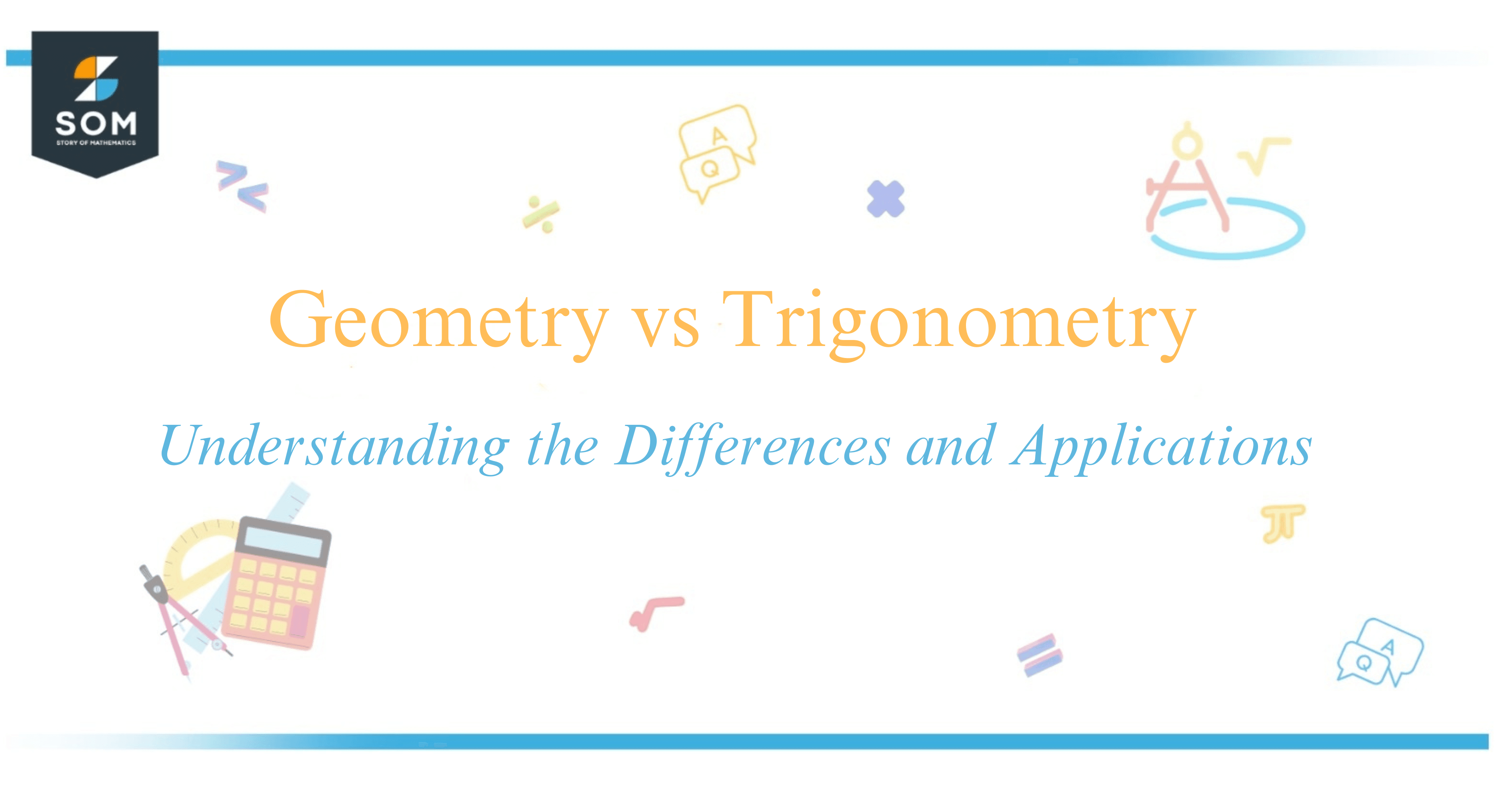JUMP TO TOPIC
 Geometry and trigonometry are two pivotal branches of mathematics that often interlock in their study of shapes, sizes, and the properties of space. In my exploration of these subjects, I’ve come to appreciate how geometry provides a broad canvas, addressing various figures and spatial relationships, while trigonometry focuses intently on the specific properties of triangles, particularly the right-angled ones.
Geometry and trigonometry are two pivotal branches of mathematics that often interlock in their study of shapes, sizes, and the properties of space. In my exploration of these subjects, I’ve come to appreciate how geometry provides a broad canvas, addressing various figures and spatial relationships, while trigonometry focuses intently on the specific properties of triangles, particularly the right-angled ones.
Both play crucial roles in applications ranging from engineering to physics and understanding their differences not only enriches my mathematical knowledge but also enhances my practical problem-solving skills.
Join me as we uncover the distinct nature of each field and how they contribute to our grasp of the mathematical world around us – you might just see the angles and lines of your environment in a whole new light.
Main Differences Between Geometry and Trigonometry
The main differences between Geometry and Trigonometry are based on their scope, application, and the specific aspects of shapes they examine. While both fields are branches of mathematics that deal with shapes and space, they focus on different elements and principles.

Scope of Study:
- Geometry: Encompasses the properties and relations of points, lines, surfaces, and solids.
- Trigonometry: Focuses specifically on the properties of triangles, especially right-angled ones.
Key Concepts:
- Geometry: Deals with a broad range of figures and concepts, such as congruence, similarity, area, and volume.
- Trigonometry: Is concerned with angle relationships, sine, cosine, tangent, and other trigonometric functions.
Applications:
- Geometry: Used in a variety of contexts, from architectural design to the computation of spatial areas.
- Trigonometry: Essential in fields that require angle measurements, such as surveying, astronomy, and physics.
Understanding these distinctions helps us appreciate how each discipline contributes uniquely to the field of mathematics and its real-world applications.
Fundamental Concepts of Geometry and Trigonometry
Geometry is a branch of mathematics that I understand to be concerned with the properties and relations of points, lines, surfaces, solids, and higher-dimensional analogs. It’s broadly categorized into two:
- Plane Geometry: Deals with shapes such as circles, triangles, rectangles, squares, and polygons that can be drawn on a flat surface.
- Solid Geometry: Explores objects like cubes, spheres, cylinders, and pyramids in three-dimensional space.
Geometry uses Euclid’s axioms as foundational principles, which serve as the bedrock of theorems about the attributes of shapes and figures. It involves various measurements like:
| Property | Measurement |
|---|---|
| Length | Meters, Feet |
| Area | Square units |
| Volume | Cubic units |
In geometry, I apply algebra and arithmetic to calculate dimensions, while the position and properties of space occupy a central role, defining the size and shape of objects.
Trigonometry, on the other hand, specifically focuses on the study of triangles, engaging with their angles and sides. The fundamental concepts here involve the trigonometric functions, which relate the ratios of sides of right triangles to their angles. These functions include:
- Sine (sin)
- Cosine (cos)
- Tangent (tan)
- Cotangent (cot)
- Secant (sec)
- Cosecant (csc)
These tools allow me to determine unknown lengths and angles of triangles. Here’s a brief overview of how these functions look like in a right-angled triangle context:
| Function | Description | Ratio |
|---|---|---|
| Sine | Opposite side over the hypotenuse | sin(θ) = o/h |
| Cosine | Adjacent side over the hypotenuse | cos(θ) = a/h |
| Tangent | Opposite side over adjacent side | tan(θ) = o/a |
The connection between geometry and trigonometry is fundamental as trigonometry is a subset of geometric principles, focusing narrowly yet profoundly on the properties of triangles, a shape essential in the geometric universe.
Applications of Geometry and Trigonometry
Geometry and trigonometry are fundamental in various fields. In construction, geometry aids in determining the material requirements and spatial dimensions for buildings. Trigonometry is critical for calculating angles and distances, making it invaluable for creating stable structures.
When it comes to architecture, I apply geometry to design aesthetically pleasing and functional spaces. Trigonometry allows me to understand how to best use light and shadows within a design, enhancing the visual impact and functionality of the spaces I create.
In surveying, my tasks often involve measuring large tracts of land. Utilizing trigonometry, I calculate distances and angles between points on a plot, which is essential for accurate mapping and planning.
Navigation relies heavily on trigonometry as well. When I navigate, I often use it to find the shortest path between two points on a spherical surface, like the Earth, which is vital for air and sea travel.
Astronomy uses both branches to observe and interpret the universe’s wonders. Geometry helps me understand the shapes and relative positions of celestial bodies, while trigonometry is vital for calculating their distances and movements.
In physics, these mathematical fields are indispensable. They allow me to model forces, motion, and energy patterns. Trigonometry, in particular, is integral in wave functions and harmonic motion.
Lastly, probability in both geometry and trigonometry enhances my understanding, such as predicting outcomes based on geometric distributions.
| Field | Geometry Use | Trigonometry Use |
|---|---|---|
| Construction | Material and space calculation | Angle and distance measurements |
| Architecture | Designing spaces and structures | Optimizing light and shadow |
| Surveying | Accurate mapping and land measurements | Calculating distances and plot angles |
| Navigation | Plotting courses on spherical surfaces | Determining shortest paths |
| Astronomy | Interpreting shapes and positions of celestial bodies | Calculating distances and movements |
| Physics | Modeling forces and structures | Analyzing wave functions and motion |
| Probability | Predicting geometric distributions | Assessing outcomes based on angles |
Geometry and trigonometry serve as foundational tools across these varied applications, each complementing the other to address complex problems in practical, real-world scenarios.
Conclusion
In summarizing, I find that geometry and trigonometry serve as two distinct, yet interrelated, branches of mathematics. Geometry is the broader discipline, focusing on the properties and relations of points, lines, shapes, and spaces. It’s here where we explore the expanse of forms – from the simplest line to the most complex n-dimensional shapes.
On the other hand, trigonometry hones in on the measurement of triangles, particularly the right-angled ones. It’s a powerful tool, which I’ve come to appreciate, for understanding the relationships between the sides and angles of these three-cornered figures. Trigonometry often proves indispensable in fields such as engineering and physics due to its precise nature in dealing with angles and distances.
I’ve learned that while one can study geometry without delving deep into trigonometry, understanding the latter requires a good grasp of the geometric fundamentals. They complement each other, with trigonometry often considered a subset of the larger geometric framework.
In my study and application of these mathematical fields, I’ve observed the unique role each plays in both theoretical and practical contexts. Their significance is undeniable in shaping the way we understand the world around us, construct buildings, navigate across the oceans, and even send satellites into space.
